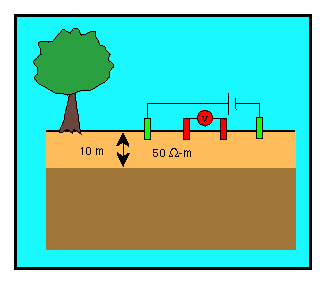

Now consider the apparent resistivity curves generated over a one-layered medium in which the resistivity of the upper layer is less than the resistivity of the halfspace. An example of this type of structure is shown to the right. A 10-meter thick, 50 ohm-m layer overlies a halfspace that has a resistivity that is always greater than 50 ohm-m.
Shown below are apparent resistivity curves computed assuming various values of resistivity for the halfspace (250, 500, 1000, 2500, 5000, 10000 ohm-m). This example is not quite as simple as the previous example. As before, all of the curves asymptotically approach the resistivity of the upper, 50 ohm-m layer at small electrode spacings. At large electrode spacings, however, the behavior is a bit more complex. If the resistivity of the halfspace is not too much larger than the resistivity of the upper layer, then the apparent resistivity does asymptotically approach the resistivity of the halfspace at obtainable electrode spacings. As the resistivity of the halfspace increases, however, the asymptotic behavior of the apparent resistivity curve manifests itself only at larger and larger electrode spacings.

In this example, notice that over the electrode spacing range considered (0.5 to 500 meters), the apparent resistivity curve never approaches the resistivity of the halfspace for halfspace resistivities above 2500 ohm-m. Instead, the apparent resistivity curve approaches a straight line having a slope of 45 degrees (blue line). Also notice that for relatively small halfspace resistivities, again like the previous case, the electrode spacing where the greatest change in apparent resistivity with electrode spacing (slope) is approximately equal to the thickness of the layer. As the resistivity of the halfspace increases, however, the electrode spacing where we observe the greatest change in apparent resistivity moves to distances larger than the depth of the layer.
